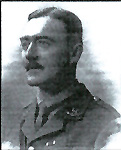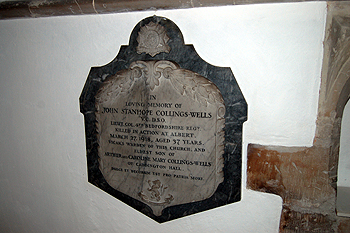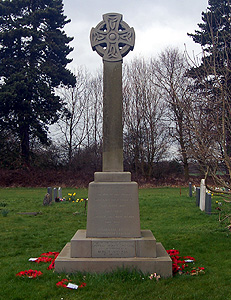John Stanhope Collings-Wells VC DSO

Acting Lieutenant-Colonel John Stanhope Collings-Wells VC DSO
The Collings Wells Memorial Hall in Caddington is named after Lieutenant-Colonel John Stanhope Collings-Wells VC DSO. He was born on 19th July 1880 and the General Register Office Index shows that he was born in Chorlton [Lancashire]. The 1881 census has him living at 3 Albert Place, Rusholme [Lancashire] with his father, 23 year old Arthur, originally from Chelmsford [Essex] and described as an engineering speciality inventor and agent and his mother, 25 year old Caroline, from Colchester [Essex]. The family was wealthy as it had two servants – Rhoda Sawyer, a 34 year old cook from Hagbourne [Berkshire] and Marian L. Robins, aged 29 and from Abingdon [Berkshire].
When John was seventeen the family moved from Mill Hill [Middlesex] to , the lease from its owner, Arthur Macnamara, being dated 6th June 1898 [MN44/1]. The 1901 census describes Arthur Collings-Wells as a mechanical engineer and gives his birthplace as Broomfield [Essex]. John is described as an undergraduate. He now had four siblings: Russell Binmore, an 18 year old student for the army, Mabel Bertha aged 17, Alice Madeline aged 15 and Leonard aged 11. The three older siblings had been born at Davyhulme [Lancashire] whilst Leonard had been born at Mill Hill [Middlesex]. They now had six servants: Lucy Youngs, aged 27, a cook, born in Ely [Cambridgeshire]; Alice Boulton, aged 26, a housemaid, born in Lillingstone Dayrell [Buckinghamshire]; May Acre, aged 19, a housemaid from Shelford [Hertfordshire]; Edith Fox, aged 23, a lady’s maid from Northampton; Louisa Gentle, aged 20, a kitchen maid from Hatfield [Hertfordshire] and Stanley Filtness, aged 20, a footman from Hadlow [Kent]. Arthur Collings Wells bought Caddington Hall from Arthur Macnamara in 1903 [MN44/4].
Before the First World War Collings-Wells served in the Hertfordshire Militia which he joined in 1904. He was also churchwarden at All Saints’ Church in Caddington. The Hertfordshire Militia was first raised in 1757. It was embodied for garrison duty at intervals of national crisis, such as during the Napoleonic Wars and then reorganised in 1852. In 1873 it was attached to 33rd Sub-District Brigade, the headquarters of which was in Bedford. In July 1881 it became part of the Bedfordshire Regiment as 4th Battalion (Hertfordshire Militia). Hertfordshire had no regular infantry regiment hence the attachment to the Bedfordshire Regiment which was the 16th Regiment of Foot.
The 4th Battalion was embodied in 1900 and volunteered for service in South Africa during the Boer War. Four years after Collings-Wells joined it the battalion was transferred to the Special Reserve as 4th (Extra Reserve) Battalion, Bedfordshire Regiment. On the outbreak of World War One in August 1914 the battalion was embodied for service as a garrison unit which also provided drafts to replace casualties in the 1st and 2nd Battalions, both serving on the Western Front.
The battalion itself was mobilised for service overseas on 10th July 1916 when it was at Landguard Camp near Felixstowe [Suffolk]. It arrived in le Havre on 26th of that month as part of 190th Brigade. The other three battalions in the brigade were 1st Battalion Honorable Artillery Company, 7th Battalion, Royal Fusiliers and 10th Battalion, Royal Dublin Fusiliers, in June 1917 the Honorable Artillery Company was replaced by 1st/28th London Regiment – “The Artists Rifles”. 190th Brigade was part of 63rd Division. This was a unique formation because the other two brigades were composed of two battalions of Royal Marines and six battalions of sailors which, being superfluous in the navy, were drafted into the army for the duration of the war – they formed battalions named after famous admirals – Anson, Drake, Hawke, Hood, Howe and Nelson. The division was thus known as 63rd (Royal Naval) Division.
Collings-Wells had actually been in France before – on 6th November 1914 when he joined 2nd Battalion, Bedfordshire Regiment as a captain. He did not serve long, being wounded on 15th January 1915 in front line trenches near Fleurbaix [X550/3/WD1501].
When he went out with 4th Battalion Collings-Wells had been promoted to major. Bedfordshire and Luton Archives and Records Service is lucky in having the war diaries of every battalion of the Bedfordshire Regiment to go on active service during World War One. 4th Battalion’s diary is, sadly, about the least interesting in that the entries are very short and do not give much information, in contrast to those for 1st, 2nd and 7th which are much more detailed.
The first action the battalion took part in was during the dying days of the Battle of the Somme which had begun on 1st July 1916. On 13th November the 63rd Division attacked German positions in waterlogged ground around Beaucourt, one of the objectives for the very first day of the battle – 136 days before. The state of the ground must have caused many wry comments from the soldiers about the need to send in the navy! Major Collings-Wells was now in command of the battalion.
The war diary [X550/5/3] simply says: “The Battalion advanced with the remainder of the Brigade at 6.45 am and sustained heavy casualties among Officers and NCOs in and near the enemy front line from a strongpoint established between enemy front line and second line which had been passed over by the leading Brigades. Battalion advanced to enemy second line and from there parties pushed forward to Station Road and beyond”. This action cost 4th Bedfords 9 officers killed, 5 wounded, 57 other ranks killed, 108 wounded and 16 missing – a total of 195 out of a probable total of around a thousand men. Collings-Wells escaped injury; he was promoted to acting lieutenant-colonel with effect from 26th October.
In June 1917 Captain (Acting Lieutenant-Colonel) Collings-Wells was awarded the Distinguished Service Order. In September he assumed temporary command of 190th Brigade for a week. On 30th October 1917 the battalion made an attack which was part of the Third Battle of Ypres, also known as the Battle of Passchendaele. The attack took place not far from that village. The war diary is typically terse: “Batt. attacked at 5.50 a.m. 7th R.F. on left, Artists Rifles on right. Canadian Corps on Right of Artists. Canadian attack was successful, but our attack was held up by very heavy and boggy ground surrounding the Paddebeek and a total advance of about 150-200 yards only was made. Casualties - Officers killed. Capt. L. C. T. Gate. 2nd Lt. A. E. Tee - Wounded. Capt. J. Scott Lt. C. H. Wareing, Lt. K. V. R. Gold. 2nd Lt. S. A. Glossop. 2nd Lt. V. Bornet. 2nd Lt. Ivey, 2nd Lt. Radwell, Other Ranks killed 52. Wounded 150. Missing 23”. Collings-Wells was subsequently mentioned in dispatches.
On 21st March 1918 the Germans launched a surprise attack on the over-extended British 5th Army, trying to make use of their extra manpower now that Russia had been knocked out of the war and before the Americans could arrive in large numbers. Their attack was very successful forcing a headlong retreat of about fifty miles. 4th Bedfords were then at a village called Ribecourt-la-Tour – all the war diary says is: “Enemy attacked and captured front line posts. Brigade were withdrawn to 2nd line defence.” Over the next few days they retreated via Neuville, Ytres, Bazentin-le-Petit and Coucelette to High Wood and Thiepval on the old Somme battlefield; the latter village had been captured by 7th Bedfords in September 1916. The town of Albert, hub of the 1916 battles and held since 1914 fell to the Germans and 4th Bedfords took up positions at Bouzincourt Ridge on 26th March. The next day they attacked – the war diary says: “Batt. was moved south to a position west of Albert where they attacked the Railway at 7.30 a. m. Lt. Col. J. S. Collings-Wells, D. S. O. Major G. P. Nunneley, 2/Lt. D. H. Macklin, 2.Lt. O. J. Soames killed, Lts. C. Keith-Johnston M. C., J. B. Primrose-Wells, 2. Lts. L. Hambling & W. Broughton wounded. Capt. L. G. Plumbly M. C. took over command of the Batt. temporarily from this date”.

John Collings-Wells memorial in the chancel June 2012
It is for this action that Collings-Wells won the Victoria Cross. The citation reads: “For most conspicuous bravery, skilful leading and handling of his battalion in very critical situations during a withdrawal”.
“When the rear guard was almost surrounded and in great danger of being captured, Lieutenant-Colonel Collings-Wells, realising the situation, called for volunteers to remain behind and hold up the enemy whilst the remainder of the rearguard withdrew and, with his small body of volunteers held them up for over one and a half hours until they had expended every round of ammunition. During this time he moved freely amongst his men, guiding them and encouraging them and, by his great courage, undoubtedly saved the situation”.
“On a subsequent occasion, when his battalion was ordered to carry out a counter -attack, he showed the greatest bravery. Knowing that his men were extremely tired after six days fighting, he placed himself in front and led the attack and, even when twice wounded, refused to leave them, but continued to lead and encourage his men until he was killed at the moment of gaining their objective. The successful results of the operation were, without doubt, due to the undaunted courage exhibited by this officer”.
He is buried in nearby Bouzincourt Ridge cemetery. His gravestone has a large Victoria Cross etched upon it. He was thirty seven years old and unmarried. By the time the entry was made for the Commonwealth War Graves Commission his parents had moved to Brand's House, Hughenden, High Wycombe [Buckinghamshire].
The Collings-Wells Memorial Hall was opened by his brother Russell (also a lieutenant-colonel and holder of the DSO) on 26th January 1935. On 24th June 2006 a plaque was unveiled on the hall due to the work of Caddington Local History Group, whose programme of the event, also giving details of Collings-Wells’ life is available as a pamphlet in the Bedfordshire and Luton Archives and Records Service searchroom.

Caddington War Memorial March 2012